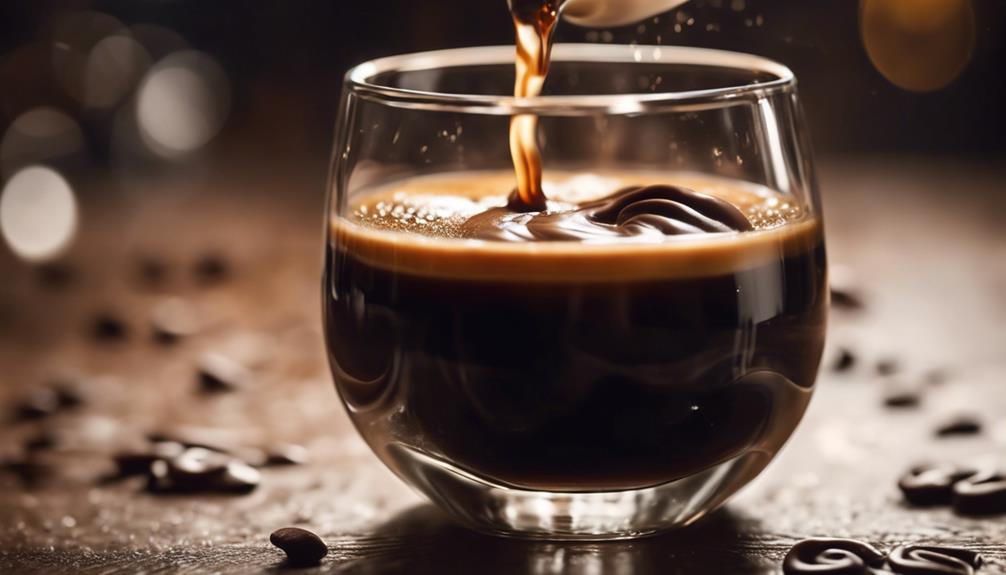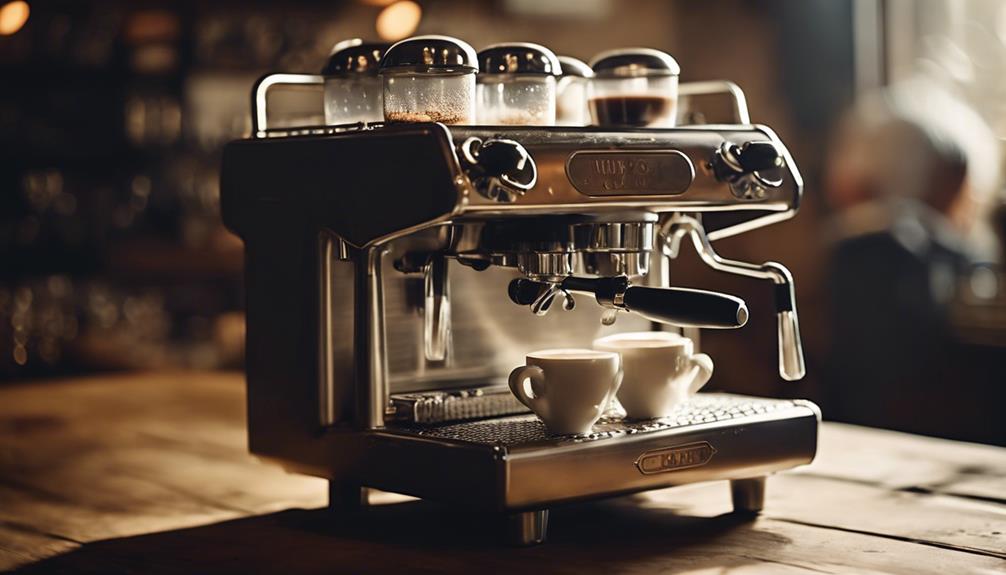You are on the verge of unlocking the key to elevating your baking skills with espresso powder! Crafted from deeply roasted coffee beans, this concentrated flavor enhancer is ideal for improving chocolate recipes. Simply use ¼ to 1 ½ teaspoons to add richness without overwhelming your desserts. Whether store-bought or homemade, espresso powder dissolves effortlessly in hot water and can be stored for up to five months in a sealed container. Thanks to its ability to enhance taste without any bitterness, you’ll be left wondering how you ever baked without it. Now, explore how to maximize its potential and elevate your baked goods into luxurious, decadent creations.
Key Takeaways
- Espresso powder is a concentrated flavor booster made from darkly roasted coffee beans, ideal for enhancing chocolate recipes.
- Homemade espresso powder can be made by baking and grinding roasted espresso beans, yielding approximately one cup of powder.
- Espresso powder elevates the flavor of baked goods, particularly chocolate desserts, without adding a strong coffee taste.
- When using espresso powder, dissolve it in hot water before adding to recipes for better flavor distribution and account for additional liquid.
Understanding Espresso Powder
To start working with espresso powder, it's essential that you understand what it's made of and how it can enhance your baked goods, especially those that feature chocolate.
Espresso powder is made from darkly roasted coffee beans that are brewed, dried, and ground into a fine powder. This process creates a concentrated flavor booster that's perfect for baking. When used in moderation, espresso powder can intensify the cocoa flavor in chocolate recipes, such as cakes and brownies, without imparting a strong coffee taste.
When working with espresso powder, it's vital to measure it carefully. The recommended amount ranges from ½ to 1 ½ teaspoons, depending on the recipe. Unlike instant coffee, espresso powder is more concentrated and dissolves easily in hot water, making it ideal for incorporation into batters and frostings.
To maintain its flavor potency, store your espresso powder in an airtight container. With proper storage, homemade espresso powder can last up to five months.
Making Your Own Espresso Powder
Now that you're familiar with the benefits and uses of espresso powder, let's explore how you can make your own at home.
To start, preheat your oven to 200°F and spread roasted espresso beans in a single layer on a baking sheet. Bake them for about an hour, or until they're lightly toasted and dried. Once cooled, grind the beans in a coffee grinder or food processor until they reach a fine powder consistency. This guarantees uniformity and ideal flavor.
You'll be pleased to know that one cup of roasted espresso beans yields approximately one cup of espresso powder, making it a cost-effective option compared to store-bought alternatives.
For the best flavor profile, use organic, medium roast espresso beans. Once you've ground your beans, store the freshly ground espresso powder in an airtight container. This will maintain its freshness and potency for up to 5 months.
With your homemade espresso powder, you can enhance your baked goods with a rich, intense flavor. Simply use it in place of store-bought espresso powder to elevate your recipes. By making your own espresso powder, you'll have complete control over the flavor and quality of your ingredients.
Using Espresso Powder in Baking

When incorporating espresso powder into your baked goods, you'll find that it can markedly enhance the chocolate flavor in treats like cakes, brownies, and cookies without imparting a strong coffee taste, as long as you use it in moderation. To get the most out of your espresso powder, dissolve it in hot water before adding it to your recipe. This guarantees ideal flavor distribution and prevents any bitter notes from forming.
| Espresso Powder Tips | Benefits |
|---|---|
| Use ¼ to 1 ½ teaspoons per recipe | Enhance chocolate flavor without strong coffee taste |
| Dissolve in hot water before adding | Prevents bitter notes and guarantees ideal flavor distribution |
| Account for additional liquid in recipes | Dissolved powder contributes moisture, affecting final texture |
When using espresso powder, you can achieve a depth of flavor similar to brewed espresso without the hassle of brewing. One teaspoon of espresso powder is equivalent to one shot of espresso, making it a convenient addition to your baking routine. Pair it with Dutch process cocoa for an intense chocolate flavor that will elevate your baked goods to the next level.
Benefits and Substitutes Explained
As you explore the benefits of using espresso powder in your baking, it's helpful to understand its role in enhancing flavor and the options available when it's not on hand. Espresso powder is a game-changer for chocolate desserts, intensifying the flavor without leaving a strong coffee taste.
If you're out of espresso powder, don't worry! You can substitute it with dry instant coffee, but keep in mind that you'll need to use 50% more than the recipe calls for.
Here are some key points to reflect on when working with espresso powder:
- Flavor enhancement: Espresso powder elevates the flavor of baked goods, especially chocolate desserts.
- Substitutes: Instant coffee can be used as a substitute, but it may lead to a slightly bitter flavor.
- Homemade option: Making your own espresso powder at home is a cost-effective alternative to store-bought options.
- Omitting espresso powder: If a recipe calls for espresso powder, you can omit it without affecting the texture of the baked goods, but the flavor will be less intense.
Enhancing Recipes With Espresso Powder

By incorporating espresso powder into your recipes, you can reveal a deeper, richer flavor profile in your chocolate desserts. When adding espresso powder to your baked goods, start with small amounts, typically between ½ to 1 ½ teaspoons, to enhance the chocolate flavor without overpowering it. This is especially effective in chocolate cakes, brownies, and cookies, where the powder can transform a basic flavor into a complex and intense taste experience.
To guarantee even distribution, dissolve the espresso powder in hot water before mixing it into batters. If you don't have espresso powder, you can substitute it with instant coffee, using 1.5 times the amount called for in the recipe. However, keep in mind that instant coffee may introduce a slightly different flavor profile.
To maintain the potency and flavor of your espresso powder, store it in an airtight container. This will allow you to enjoy the rich dessert profile it provides for up to five months.
Frequently Asked Questions
Can You Use Espresso Powder for Baking?
You're wondering if you can use espresso powder for baking? Absolutely, you can! Espresso powder is a game-changer in baking, intensifying chocolate flavors without leaving a strong coffee taste, and it's easy to incorporate into your recipes.
What Does Espresso Do in Baking?
When you bake with espresso powder, you'll find that it amplifies the chocolate flavor without leaving a coffee taste, adds richness and complexity to desserts like cakes and cookies, and deepens their flavor profile overall.
Does Espresso Powder Enhance Chocolate Flavor?
Like a master painter adding depth to a canvas, you'll discover that espresso powder is the secret ingredient that elevates your chocolate baked goods, amplifying the richness and complexity of the cocoa flavor, making it truly decadent.
What Is the Benefit of Espresso Powder?
You're about to reveal the secret to intensifying flavors in your baked goods! By incorporating espresso powder, you'll add depth, richness, and a hint of complexity, transforming your desserts and elevating them to the next level.
How Can Espresso Powder Enhance the Flavor in Baking?
Espresso powder, made from the finely ground meaning of espresso beans, can intensify the chocolate flavor in baked goods. Its rich and robust taste adds depth to recipes, making them more flavorful and decadent. Just a small amount can significantly enhance the overall taste and aroma of your baked treats.
Conclusion
You've made it to the end of the ultimate guide to espresso powder!
Now, go ahead and elevate your baked goods to the next level.
Did you know that the average American consumes 2.1 cups of coffee per day? That's a lot of buzz!
With espresso powder, you can capture that same energy in your recipes.
Experiment with it, and you'll be hooked.
Your taste buds (and your coffee-loving friends) will thank you.
Happy baking!









